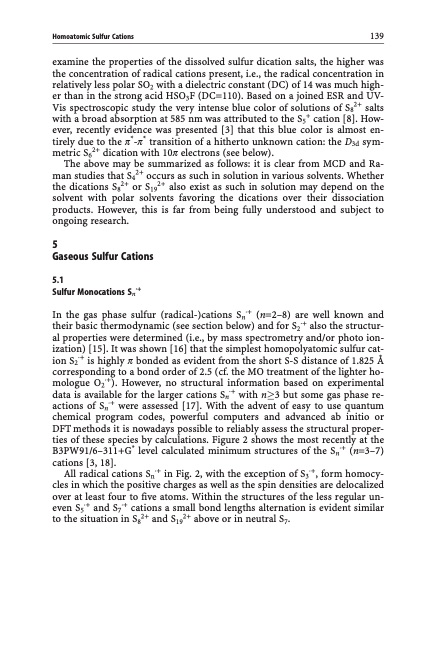
PDF Publication Title:
Text from PDF Page: 149
Homoatomic Sulfur Cations 139 examine the properties of the dissolved sulfur dication salts, the higher was the concentration of radical cations present, i.e., the radical concentration in relatively less polar SO2 with a dielectric constant (DC) of 14 was much high- er than in the strong acid HSO3F (DC=110). Based on a joined ESR and UV- Vis spectroscopic study the very intense blue color of solutions of S82+ salts with a broad absorption at 585 nm was attributed to the S5+ cation [8]. How- ever, recently evidence was presented [3] that this blue color is almost en- tirely due to the p*-p* transition of a hitherto unknown cation: the D3d sym- metric S62+ dication with 10p electrons (see below). The above may be summarized as follows: it is clear from MCD and Ra- man studies that S42+ occurs as such in solution in various solvents. Whether the dications S82+ or S192+ also exist as such in solution may depend on the solvent with polar solvents favoring the dications over their dissociation products. However, this is far from being fully understood and subject to ongoing research. 5 Gaseous Sulfur Cations 5.1 Sulfur Monocations Sn·+ In the gas phase sulfur (radical-)cations Sn·+ (n=2–8) are well known and their basic thermodynamic (see section below) and for S2·+ also the structur- al properties were determined (i.e., by mass spectrometry and/or photo ion- ization) [15]. It was shown [16] that the simplest homopolyatomic sulfur cat- ion S2·+ is highly p bonded as evident from the short S-S distance of 1.825 corresponding to a bond order of 2.5 (cf. the MO treatment of the lighter ho- mologue O2·+). However, no structural information based on experimental data is available for the larger cations Sn·+ with n3 but some gas phase re- actions of Sn·+ were assessed [17]. With the advent of easy to use quantum chemical program codes, powerful computers and advanced ab initio or DFT methods it is nowadays possible to reliably assess the structural proper- ties of these species by calculations. Figure 2 shows the most recently at the B3PW91/6–311+G* level calculated minimum structures of the Sn·+ (n=3–7) cations [3, 18]. All radical cations Sn·+ in Fig. 2, with the exception of S3·+, form homocy- cles in which the positive charges as well as the spin densities are delocalized over at least four to five atoms. Within the structures of the less regular un- even S5·+ and S7·+ cations a small bond lengths alternation is evident similar to the situation in S82+ and S192+ above or in neutral S7.PDF Image | Topics in Current Chemistry

PDF Search Title:
Topics in Current ChemistryOriginal File Name Searched:
Elemental-Sulfur-und-Sulfur-Rich-Compounds-I.pdfDIY PDF Search: Google It | Yahoo | Bing
Sulfur Deposition on Carbon Nanofibers using Supercritical CO2 Sulfur Deposition on Carbon Nanofibers using Supercritical CO2. Gamma sulfur also known as mother of pearl sulfur and nacreous sulfur... More Info
CO2 Organic Rankine Cycle Experimenter Platform The supercritical CO2 phase change system is both a heat pump and organic rankine cycle which can be used for those purposes and as a supercritical extractor for advanced subcritical and supercritical extraction technology. Uses include producing nanoparticles, precious metal CO2 extraction, lithium battery recycling, and other applications... More Info
| CONTACT TEL: 608-238-6001 Email: greg@infinityturbine.com | RSS | AMP |